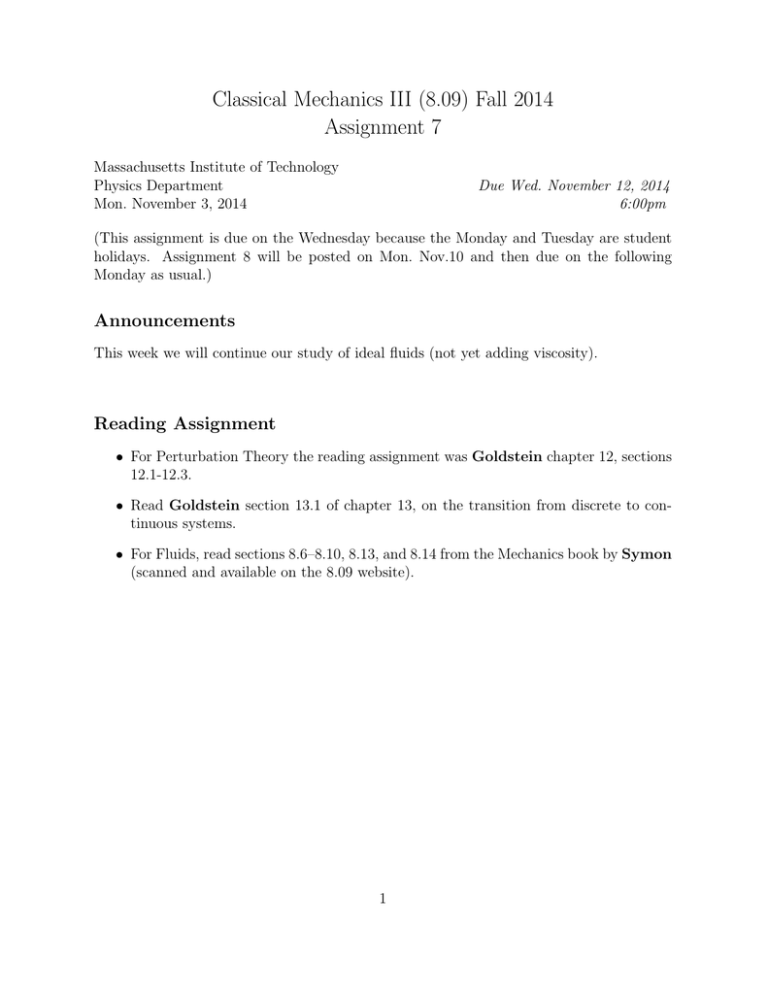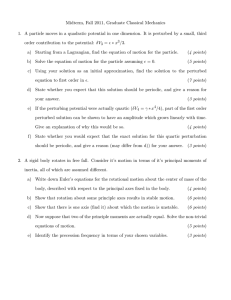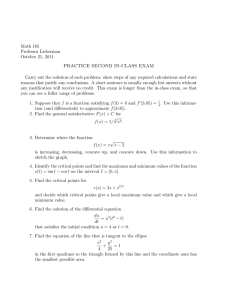Mechanics III (8.09) Fall 2014 Classical 7 Assignment
advertisement

Classical Mechanics III (8.09) Fall 2014 Assignment 7 Massachusetts Institute of Technology Physics Department Mon. November 3, 2014 Due Wed. November 12, 2014 6:00pm (This assignment is due on the Wednesday because the Monday and Tuesday are student holidays. Assignment 8 will be posted on Mon. Nov.10 and then due on the following Monday as usual.) Announcements This week we will continue our study of ideal fluids (not yet adding viscosity). Reading Assignment • For Perturbation Theory the reading assignment was Goldstein chapter 12, sections 12.1-12.3. • Read Goldstein section 13.1 of chapter 13, on the transition from discrete to con­ tinuous systems. • For Fluids, read sections 8.6–8.10, 8.13, and 8.14 from the Mechanics book by Symon (scanned and available on the 8.09 website). 1 Physics 8.09, Classical Physics III, Fall 2014 2 Problem Set 7 On this problem set there are two problems on perturbation theory and two problems on fluids. Feel free to use a package like mathematica or matlab to help with any integrals. 1. Perturbation Theory for Two Springs [10 points] (see also Goldstein Ch.12 #5) A mass is constrained to move on a straight line and is attached to the ends of two ideal springs. Each spring has a force constant k and unstretched length b. In the figure take the distance a > b. k θ m θ k a a Image by MIT OpenCourseWare. (a) [3 points] What is the Hamiltonian H for this system in terms of canonical co­ ordinates θ and pθ ? (b) [2 points] Expand your result from (a) about θ = 0 and identify H = H0 + ΔH, where you have a harmonic oscil­ lator Hamiltonian for H0 . To determine ΔH keep only the first order corrections counting θ ∼ pθ (ie. θ and pθ are the same size for the expansion). (c) [5 points] Using first order perturbation theory find the secular change to the frequency from ΔH, and show that there is no secular change to the amplitude. 2. Second Order Perturbation Theory [18 points] (see also Goldstein Ch.12 #4) Consider the Hamiltonian for a simple pendulum for a mass m on a rigid rod of length a, with angle θ to the vertical: H= p2θ Iω 2 θ2 p2 + ΔH = −Iω 2 + H0 + ΔH , − Iω 2 cos θ = −Iω 2 + θ + 2I 2I 2 where I = ma2 and ω 2 = g/a. In lecture we took canonical variables (β, J) and considered the first order results β (1) and J (1) . In this problem you will work out what happens at second order in perturbation theory. To simplify some of the algebra, you should assume that β (0) = 0 throughout. [You should feel free to use a program like mathematica to evaluate integrals, do series expansions, and collect algebra. Do write out all your intermediate results so you can be given partial credit if anything goes wrong.] (a) [2 points] Identify ΔH = ΔH1 + ΔH2 where the two terms are ∝ θ4 and ∝ θ6 respectively. (b) [4 points] Using ΔH1 repeat the first order analysis in lecture, but now solve analytically for β (1) (t) ≡ β (0) + ν1 t + β1 (t) and J (1) (t) ≡ J (0) + J1 (t) without Physics 8.09, Classical Physics III, Fall 2014 3 doing a time average. Here the β1 (t) and J1 (t) terms oscillate, while ν1 is a constant. There will be two types of corrections at second order in perturbation theory. One comes from treating ΔH1 to second order in perturbation theory. The other comes from treating ΔH2 as a first order perturbation. We can solve for these two corrections (2) (2) independently and then add them to obtain the full solution, so let β (2) = βa + βb (2) (2) and J (2) = Ja + Jb where the subscripts a and b correspond to the terms found using ΔH1 and ΔH2 respectively. (2) (2) and J˙b using ΔH2 . Take the time average (2) (2) and determine whether there are secular changes. That is find β˙ b and J˙b . (c) [4 points] Derive equations for β̇b (2) (2) (d) [8 points] Derive equations for β˙ a and J˙a using ΔH1 . In order to determine whether there are additional secular changes we will perform the time average accounting for the secular change already found at first order. In your expres­ sions set νt+β (1) (t) = ν (1) t+β1 (t) where ν (1) = ν +ν1 . Then expand the RHS of these equations to first order in β1 (t) and J1 (t), and then use your results from (2) (2) (b). Now determine whether there are secular changes, that is find β̇a and J˙a but in this part only, average with 1 τ (1) Z τ (1) dt where τ (1) = 1/ν (1) . 0 To do the averages set 2πν (1) t = φ. Also you may set 2πνt = φ, since in the second order terms this replacement is valid up to terms beyond second order. Add your result to (c) to find final results for β˙ (2) and J˙(2) . Physics 8.09, Classical Physics III, Fall 2014 4 3. Fluid Siphon Producing a Jet [18 points] A tube of constant area AT is used as a siphon, and it steadily draws water (taken to be an ideal incompressible fluid) from an infinitely large reservoir as shown. The fluid exits the siphon at (A) with a velocity ve at an angle θ to the horizontal. Here (A) is at a height H1 below the surface of the reservoir, and the top of the siphon is at a height H2 above this surface. A narrow water jet is produced at (A) and is a steady flow. We denote the atmospheric pressure by pa . (a) [3 points] What is the velocity ve in terms of g and H1 ? A B pa Free jet pa Ve H3 pa y H2 (b) [3 points] At the top of the siphon, what is the velocity? what is the pressure? H1 (c) [5 points] What is the area A of the jet as a function of AT , H1 , θ and the height y of that portion of the jet? [In parts (c)–(e) ne­ glect the vertical size of the jet relative to y, and assume that l · lv = 0 inside the jet.] Image by MIT OpenCourseWare. (d) [2 points] What is maximum height H3 of the jet in terms of the parameters given in the problem? (e) [5 points] Derive a formula y = y(x) describing a streamline in the jet (the streamline is also a pathline). Parameters may also appear in your answer. 4. Fluid Angular Momentum and a Vortex without Vorticity [14 points] (a) [5 points] Consider the angular momentum density l = lr × (ρlv ) where lr extends from a fixed origin out to a fixed location (x, y, z) in the fluid. Derive a conser­ vation law for l making use of results from lecture and including gravity. Write your result in a similar form to what we found for linear momentum, i.e.: ∂l l ˆ l + · J = Q. ∂t You should find an equation for the angular momentum flux density tensor Jij , as well as for the external vector source term Qi . Now consider a horizontal tank with a small hole in the center. An incompressible ideal fluid rapidly rotates around the hole in an essentially circular path, creeping slowly inward in a tight spiral. Everywhere but near the hole we can treat the flow Physics 8.09, Classical Physics III, Fall 2014 5 as steady. (Near the hole viscosity matters so for now we cut this region out of our ~ × lv = 0. considerations.) Take this steady fluid to have zero vorticity, ∇ (b) [4 points] Using a result derived with Stoke’s theorem and a suitably chosen closed curve C, show that the angular velocity θ̇ ∝ 1/r2 where r is the radial distance from the hole. (Note that you are only allowed to draw C so that the region inside has steady fluid flow. If you instead draw a circle with the hole at its center you will quickly realize that there is vorticity in the hole region.) (c) [5 points] Show that for this steady incompressible fluid the result from (a) implies d(ẑ · ~l`)/dt = 0. Use this to find the constant of proportionality for your result in (b). MIT OpenCourseWare http://ocw.mit.edu 8.09 Classical Mechanics III Fall 2014 For information about citing these materials or our Terms of Use, visit: http://ocw.mit.edu/terms.



